-
 Bitcoin
Bitcoin $106,782.3966
-0.72% -
 Ethereum
Ethereum $2,406.7764
-1.16% -
 Tether USDt
Tether USDt $1.0005
0.02% -
 XRP
XRP $2.0918
-1.53% -
 BNB
BNB $644.5785
-0.17% -
 Solana
Solana $141.0925
-0.69% -
 USDC
USDC $1.0000
0.02% -
 TRON
TRON $0.2721
0.18% -
 Dogecoin
Dogecoin $0.1585
-1.26% -
 Cardano
Cardano $0.5497
-1.14% -
 Hyperliquid
Hyperliquid $35.8493
-1.58% -
 Bitcoin Cash
Bitcoin Cash $502.3089
2.20% -
 Sui
Sui $2.7092
3.87% -
 Chainlink
Chainlink $12.8551
-1.85% -
 UNUS SED LEO
UNUS SED LEO $9.0548
0.53% -
 Stellar
Stellar $0.2344
-0.85% -
 Avalanche
Avalanche $17.2676
-0.23% -
 Toncoin
Toncoin $2.8282
0.56% -
 Shiba Inu
Shiba Inu $0.0...01113
-1.14% -
 Litecoin
Litecoin $83.9593
-0.93% -
 Hedera
Hedera $0.1447
0.82% -
 Monero
Monero $306.9022
-2.07% -
 Bitget Token
Bitget Token $4.6358
3.42% -
 Dai
Dai $0.9999
0.01% -
 Ethena USDe
Ethena USDe $1.0001
0.02% -
 Polkadot
Polkadot $3.3211
0.06% -
 Uniswap
Uniswap $6.8775
0.75% -
 Pi
Pi $0.5664
-0.27% -
 Aave
Aave $256.0055
1.28% -
 Pepe
Pepe $0.0...09013
-3.24%
What types of ETH wallet addresses are there? Distinguish between hot wallets and cold wallets
ETH wallets, essential for managing ETH and ERC-20 tokens, come in hot and cold varieties, each offering different levels of security and convenience.
May 13, 2025 at 01:14 am
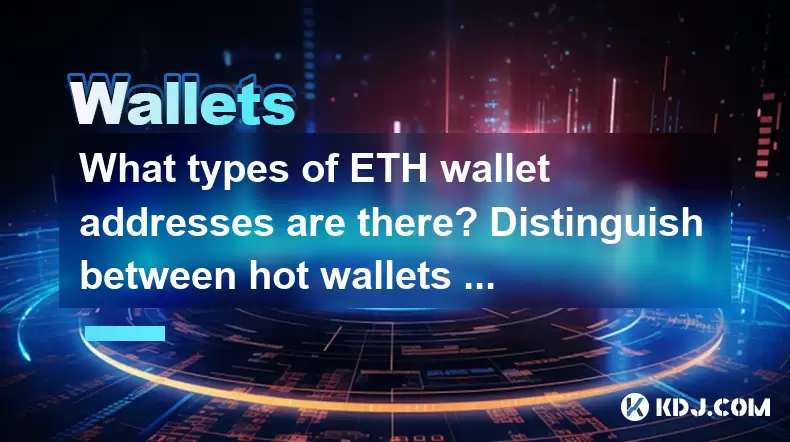
Ethereum (ETH) wallets are essential tools for managing, storing, and transacting with ETH and other ERC-20 tokens. These wallets come in various forms, each with unique features and security levels. In the cryptocurrency world, wallets are broadly categorized into hot wallets and cold wallets. This article will explore the different types of ETH wallet addresses and distinguish between hot and cold wallets.
Understanding ETH Wallet Addresses
An ETH wallet address is a unique string of alphanumeric characters that serves as the destination for sending and receiving ETH. These addresses typically start with "0x" and are 40 characters long. There are several types of ETH wallet addresses, including:
- Standard Address: This is the most common type of ETH address used for transactions on the Ethereum blockchain.
- Contract Address: These addresses belong to smart contracts deployed on the Ethereum network. They are used to interact with the contract's functionalities.
- ENS (Ethereum Name Service) Address: This is a human-readable address that maps to a standard ETH address, making it easier to remember and use.
Hot Wallets: Features and Types
Hot wallets are connected to the internet, making them convenient for frequent transactions but also more vulnerable to hacks and cyber attacks. Here are some common types of hot wallets used for ETH:
- Software Wallets: These are applications installed on a computer or mobile device. Examples include MetaMask, Trust Wallet, and Coinbase Wallet. Software wallets offer a user-friendly interface and are suitable for daily transactions.
- Web Wallets: These are accessible through a web browser and are provided by cryptocurrency exchanges or wallet services. Examples include MyEtherWallet and wallets offered by exchanges like Binance and Kraken. Web wallets are convenient but often considered less secure than other types of hot wallets.
- Mobile Wallets: These are apps designed for smartphones, offering the convenience of managing ETH on the go. Trust Wallet and Coinomi are popular mobile wallets that support ETH and various tokens.
Cold Wallets: Features and Types
Cold wallets are offline storage solutions, offering enhanced security by keeping private keys away from internet-connected devices. They are ideal for long-term storage of large amounts of ETH. Here are the main types of cold wallets:
- Hardware Wallets: These are physical devices that store private keys offline. Popular hardware wallets for ETH include Ledger Nano S, Ledger Nano X, and Trezor. Hardware wallets are considered the most secure option for storing cryptocurrencies.
- Paper Wallets: These are physical documents that contain the public and private keys printed on them. Paper wallets are created using a generator tool and are completely offline. However, they require careful handling to prevent loss or damage.
- Offline Software Wallets: These are software wallets that can be used in an offline mode, such as Electrum in cold storage mode. Users can generate and store keys offline, then sign transactions offline and broadcast them online.
Distinguishing Between Hot and Cold Wallets
The primary difference between hot and cold wallets lies in their connection to the internet and the level of security they provide. Here's a detailed comparison:
- Security: Cold wallets offer higher security because they are not connected to the internet, reducing the risk of hacking and unauthorized access. Hot wallets, while convenient, are more susceptible to cyber attacks due to their online nature.
- Convenience: Hot wallets are more convenient for frequent transactions and daily use. They allow quick access to funds and easy interaction with decentralized applications (dApps). Cold wallets are less convenient for regular transactions but are ideal for long-term storage and security.
- Accessibility: Hot wallets can be accessed from any device with an internet connection, making them highly accessible. Cold wallets, especially hardware and paper wallets, require physical access to the device or document, which can be less accessible but more secure.
- Cost: Hot wallets are often free or low-cost, as they are typically software or web-based. Cold wallets, particularly hardware wallets, come with a higher upfront cost but provide enhanced security and peace of mind.
Choosing the Right ETH Wallet
Selecting the right ETH wallet depends on your specific needs and preferences. Here are some considerations to help you choose:
- Purpose: If you need to transact frequently, a hot wallet like MetaMask or Trust Wallet might be suitable. For long-term storage and high security, a cold wallet like Ledger or Trezor is recommended.
- Security Needs: If security is your top priority, opt for a cold wallet. If you're willing to trade some security for convenience, a hot wallet could be more appropriate.
- User Experience: Consider the user interface and ease of use. Software and mobile wallets often provide a more user-friendly experience, while hardware wallets may require more technical knowledge.
- Budget: Assess your budget. Hot wallets are generally free or low-cost, while cold wallets like hardware devices have a higher initial cost.
How to Set Up an ETH Wallet
Setting up an ETH wallet involves a few key steps, which vary depending on the type of wallet you choose. Here's a general guide for setting up different types of wallets:
Setting Up a Software Wallet (e.g., MetaMask):
- Download and install the MetaMask extension from the Chrome Web Store or the MetaMask app from your mobile app store.
- Open MetaMask and click on "Create a New Wallet."
- Set a strong password and click "Create."
- Backup your recovery phrase by writing down the 12-word seed phrase. Store it in a secure place.
- Confirm the recovery phrase by selecting the words in the correct order.
- Your wallet is now set up, and you can start sending and receiving ETH.
Setting Up a Hardware Wallet (e.g., Ledger Nano S):
- Purchase a Ledger Nano S from the official Ledger website or an authorized reseller.
- Connect the Ledger device to your computer using the provided USB cable.
- Follow the on-screen instructions to set up your device, including setting a PIN.
- Install the Ledger Live software on your computer.
- Open Ledger Live and select "Add Account" to add an Ethereum account.
- Follow the prompts to set up your ETH account on the Ledger device.
- Backup your recovery phrase by writing down the 24-word seed phrase. Store it in a secure place.
- Your hardware wallet is now set up, and you can manage your ETH securely.
Setting Up a Paper Wallet:
- Visit a reputable paper wallet generator website, such as MyEtherWallet.
- Click on "Generate a New Wallet" and follow the instructions to create a new ETH address.
- Print the generated public and private keys on a piece of paper. Ensure that the printer is not connected to the internet.
- Store the paper wallet in a secure, fireproof, and waterproof location.
- Your paper wallet is now ready for use to store ETH offline.
Frequently Asked Questions
Q: Can I use both hot and cold wallets together?
A: Yes, many users utilize a combination of hot and cold wallets to balance security and convenience. You can store the majority of your ETH in a cold wallet for long-term security and keep a smaller amount in a hot wallet for daily transactions.
Q: How do I transfer ETH from a hot wallet to a cold wallet?
A: To transfer ETH from a hot wallet to a cold wallet, follow these steps:
- Open your hot wallet and select the "Send" option.
- Enter the cold wallet's ETH address as the recipient.
- Specify the amount of ETH you want to transfer.
- Confirm the transaction details and submit the transaction.
- Once the transaction is confirmed on the Ethereum blockchain, the ETH will be transferred to your cold wallet.
Q: Are there any fees associated with using ETH wallets?
A: Yes, there are fees associated with using ETH wallets, primarily related to transaction fees on the Ethereum network. These fees, known as gas fees, are paid to miners for processing transactions and smart contract executions. The amount of the fee depends on network congestion and the complexity of the transaction.
Q: How can I recover my ETH if I lose access to my wallet?
A: If you lose access to your wallet, you can recover your ETH using the recovery phrase (also known as the seed phrase) that you backed up during wallet setup. Here's how:
- For software wallets like MetaMask, download and install the wallet again, then select "Import Wallet" and enter your recovery phrase.
- For hardware wallets like Ledger, use the recovery phrase to restore your device to its original state.
- For paper wallets, use the private key printed on the paper to access your ETH through a compatible wallet or exchange.
Disclaimer:info@kdj.com
The information provided is not trading advice. kdj.com does not assume any responsibility for any investments made based on the information provided in this article. Cryptocurrencies are highly volatile and it is highly recommended that you invest with caution after thorough research!
If you believe that the content used on this website infringes your copyright, please contact us immediately (info@kdj.com) and we will delete it promptly.
- Smart Investors Navigate the AI Token Frenzy: Bitcoin Switch and Beyond
- 2025-06-28 12:30:12
- Crypto in 2025: How Web3 AI is Poised to Dominate
- 2025-06-28 12:30:12
- Solana's Support Level Holds as MACD Crossover Hints at Potential Bullish Reversal
- 2025-06-28 12:50:12
- Cathie Wood's Ark Invest: Navigating Coinbase (COIN) and SoFi (SOFI) in a Shifting Market
- 2025-06-28 12:53:43
- Crypto 2025: Spotting the Top Coins with Real Utility
- 2025-06-28 12:42:12
- Pepe Price's Wild Ride: Cryptocurrency Milestone or Just Another Meme?
- 2025-06-28 12:42:13
Related knowledge

How to stake cryptocurrencies on Coinbase? Benefits and risks
Jun 27,2025 at 06:36pm
Understanding Cryptocurrency Staking on CoinbaseStaking cryptocurrencies involves locking up digital assets to support the operations of a blockchain network, typically in return for rewards. Coinbase, one of the most popular cryptocurrency exchanges globally, offers staking services for several proof-of-stake (PoS) coins. Users can stake their holdings...
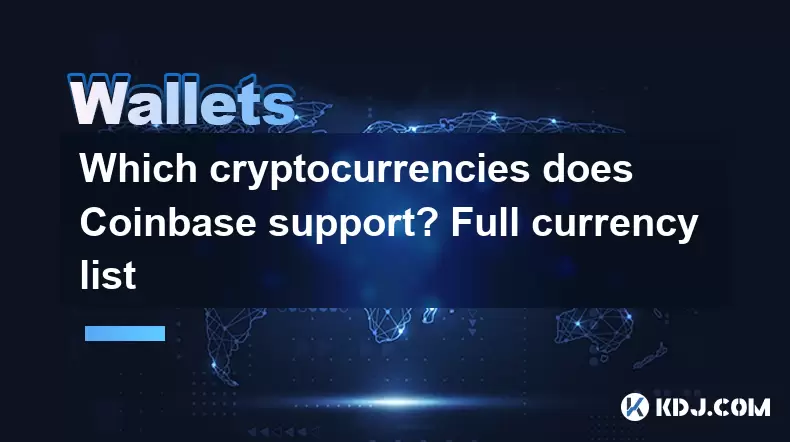
Which cryptocurrencies does Coinbase support? Full currency list
Jun 28,2025 at 08:36am
Overview of Cryptocurrencies Supported by CoinbaseCoinbase is one of the most popular and trusted cryptocurrency exchanges globally. It provides users with a platform to buy, sell, trade, and store various digital assets. As of the latest updates, Coinbase supports over 200 cryptocurrencies, including major ones like Bitcoin (BTC), Ethereum (ETH), and L...
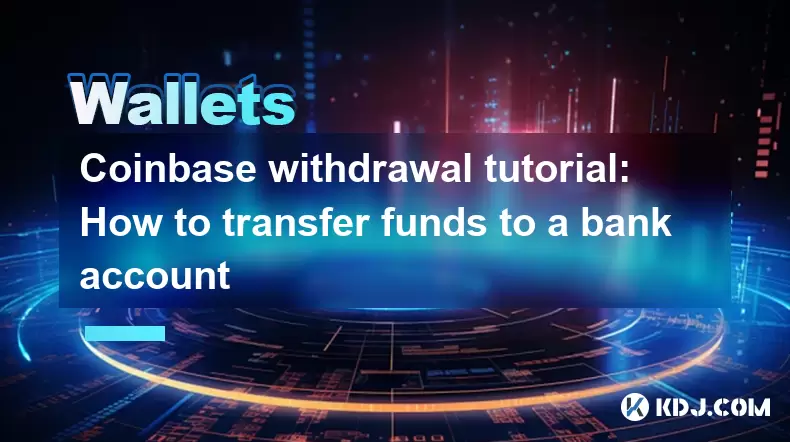
Coinbase withdrawal tutorial: How to transfer funds to a bank account
Jun 28,2025 at 02:35am
Understanding Coinbase WithdrawalsCoinbase is one of the most widely used cryptocurrency platforms, allowing users to buy, sell, and store digital assets. Once you've successfully traded or held your crypto on Coinbase, the next logical step may be to withdraw funds to a bank account. This process involves converting your cryptocurrency into fiat curren...
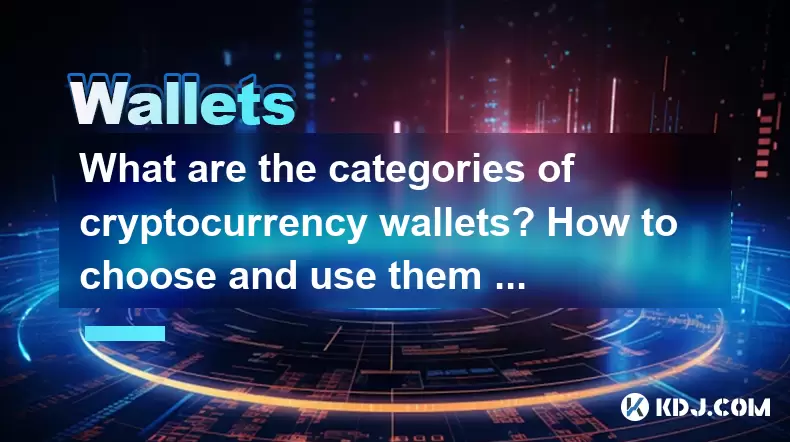
What are the categories of cryptocurrency wallets? How to choose and use them safely?
Jun 21,2025 at 10:42pm
Understanding Cryptocurrency WalletsCryptocurrency wallets are essential tools for anyone involved in the digital asset ecosystem. They allow users to store, send, and receive cryptocurrencies securely. Unlike traditional wallets that hold physical money, crypto wallets manage cryptographic keys—private and public—which interact with blockchain networks...
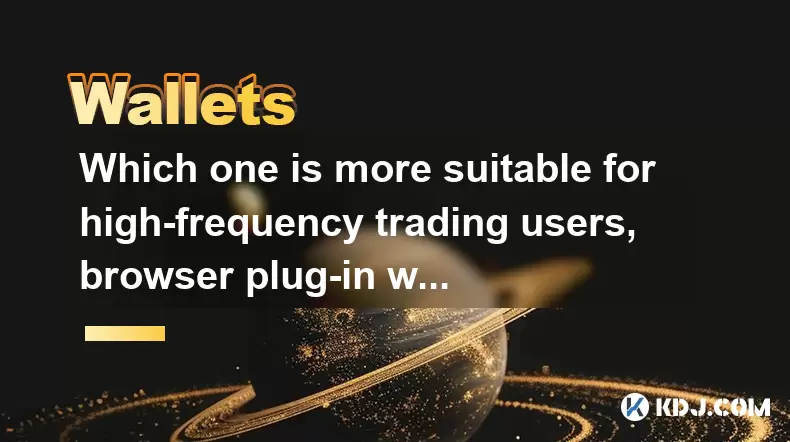
Which one is more suitable for high-frequency trading users, browser plug-in wallets or independent application wallets?
Jun 23,2025 at 08:22am
Understanding the Role of Wallets in High-Frequency TradingFor high-frequency trading (HFT) users in the cryptocurrency market, wallet selection is critical due to the need for speed, security, and seamless integration with trading platforms. HFT involves executing a large number of trades within seconds or even milliseconds, which demands a wallet that...

What are the differences between the operating mechanisms of on-chain wallets and off-chain wallets? Is there a big difference in transaction fees?
Jun 25,2025 at 08:49am
Understanding On-Chain WalletsOn-chain wallets are digital wallets that directly interact with the blockchain network. These wallets store users' private keys, which are essential for signing and authorizing transactions on the blockchain. When using an on-chain wallet, every transaction must be recorded and verified by the decentralized nodes in the ne...

How to stake cryptocurrencies on Coinbase? Benefits and risks
Jun 27,2025 at 06:36pm
Understanding Cryptocurrency Staking on CoinbaseStaking cryptocurrencies involves locking up digital assets to support the operations of a blockchain network, typically in return for rewards. Coinbase, one of the most popular cryptocurrency exchanges globally, offers staking services for several proof-of-stake (PoS) coins. Users can stake their holdings...

Which cryptocurrencies does Coinbase support? Full currency list
Jun 28,2025 at 08:36am
Overview of Cryptocurrencies Supported by CoinbaseCoinbase is one of the most popular and trusted cryptocurrency exchanges globally. It provides users with a platform to buy, sell, trade, and store various digital assets. As of the latest updates, Coinbase supports over 200 cryptocurrencies, including major ones like Bitcoin (BTC), Ethereum (ETH), and L...

Coinbase withdrawal tutorial: How to transfer funds to a bank account
Jun 28,2025 at 02:35am
Understanding Coinbase WithdrawalsCoinbase is one of the most widely used cryptocurrency platforms, allowing users to buy, sell, and store digital assets. Once you've successfully traded or held your crypto on Coinbase, the next logical step may be to withdraw funds to a bank account. This process involves converting your cryptocurrency into fiat curren...

What are the categories of cryptocurrency wallets? How to choose and use them safely?
Jun 21,2025 at 10:42pm
Understanding Cryptocurrency WalletsCryptocurrency wallets are essential tools for anyone involved in the digital asset ecosystem. They allow users to store, send, and receive cryptocurrencies securely. Unlike traditional wallets that hold physical money, crypto wallets manage cryptographic keys—private and public—which interact with blockchain networks...

Which one is more suitable for high-frequency trading users, browser plug-in wallets or independent application wallets?
Jun 23,2025 at 08:22am
Understanding the Role of Wallets in High-Frequency TradingFor high-frequency trading (HFT) users in the cryptocurrency market, wallet selection is critical due to the need for speed, security, and seamless integration with trading platforms. HFT involves executing a large number of trades within seconds or even milliseconds, which demands a wallet that...

What are the differences between the operating mechanisms of on-chain wallets and off-chain wallets? Is there a big difference in transaction fees?
Jun 25,2025 at 08:49am
Understanding On-Chain WalletsOn-chain wallets are digital wallets that directly interact with the blockchain network. These wallets store users' private keys, which are essential for signing and authorizing transactions on the blockchain. When using an on-chain wallet, every transaction must be recorded and verified by the decentralized nodes in the ne...
See all articles























































































